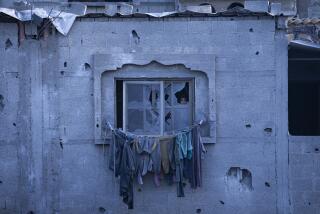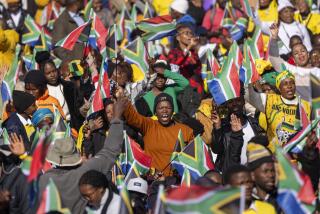Mine Field of Rules : Press Walks a Tightrope in S. Africa
- Share via
PIETERMARITZBURG, South Africa — As the evening deadline loomed, editors at the Natal Witness carefully studied a photograph of 6-year-old Victoria Gasa. The black girl’s right eye, injured when she tripped while fleeing an outbreak of political violence, was swollen shut. Her baby sister was in her arms.
The photo would convey, in a way that words could not, the human toll of four years of bloody fighting in the black townships around this tranquil farming community.
But some of the editors were afraid to use it.
One noted that the police were already investigating six charges against the newspaper for publishing photos of property damaged in political unrest. In South Africa, it is illegal to photograph political violence or its effects.
Mindful of Police View
“It’s a very powerful picture,” news editor John Davies said. “But the cops might construe it as showing the aftermath of unrest. Perhaps we could argue that it was a result of unrest but not caused by unrest.”
“They may come after us,” Paul Rayburn, the chief copy editor, said. “But it’s a picture we ought to be using.”
Every day in this newsroom, editors of the Natal Witness weigh their readers’ right to know against the government’s press restrictions--and risk fines, jail terms and, ultimately, the newspaper’s closure.
All across South Africa today, newspaper staffs hike through a mine field of often overlapping regulations, both permanent and temporary, that control how they report the news, whom they photograph and, in the end, what they publish.
A Gutsy Publication
Amid all the restrictions, many newspapers still battle to maintain their freedom. The Witness, circulation 26,000, the country’s oldest and one of its last independently owned newspapers, is widely regarded as a gutsy publication willing to test the limits of the law to report on political violence that surrounds its community.
“Not so long ago, we wouldn’t have thought twice about using a photograph like that,” Rayburn said. “We’re being more careful about it now, which is probably a good thing. If we can get the police off our backs, perhaps we can push a little bit harder next time.”
The Witness published the photo of Victoria Gasa with a cautiously worded caption explaining that she hurt her eye while fleeing an attack but that it had become infected because her mother was too frightened to seek medical treatment.
The next morning at police headquarters, a few doors from the Witness building, Brig. Jac Buchner opened his copy of the day’s paper to the photograph and read the caption.
“I suppose if we really pushed it we could make a case” against the paper’s use of the photograph, said Buchner, the security police chief for Natal province. But he did not feel like pushing it that day: “We won’t even bother to take it up.”
Richard Steyn, the Witness’ 45-year-old editor, said later: “It’s a kind of Alice in Wonderland situation. We have a perfectly normal picture, and we’ve got to argue about angels dancing on the head of a pin. But those are the kinds of judgments one’s got to make in South Africa today.”
The law has always been especially strict for journalists in South Africa, but the number of legal hurdles increased sharply three years ago when an emergency decree gave the government broad powers to curtail civil rights without hearing or appeal.
“Before, you could at least fight censorship in independent courts,” said David Dison, a Johannesburg lawyer whose firm represents hundreds of journalists. “Now if the (government) minister thinks you have breached the law, then you have.”
The penalty is $10,000, 10 years in jail or suspension of publication, as has happened to several weekly newspapers. For foreign journalists, the penalty is expulsion from South Africa. The laws are not completely enforced, however, and lawyers say journalists must learn which violations most anger the government.
Technical Violations
During a typical recent week at the Witness, the editors published constitutional proposals from the outlawed African National Congress, a detailed story about the death of two people in political violence and the photograph of Victoria Gasa. Each was technically a violation of the law.
“We don’t deliberately defy the law,” editor Steyn said, “but if you took the letter of the law you’d never get a paper out. So we’re always working out whether we’re likely to be prosecuted. Where the law is ambiguous or where there is the opportunity to publish, we go for them.”
Publishing the African National Congress’ proposed constitution, for example, could be regarded as enhancing the image of a banned organization.
But Davies, the news editor, said he decided to run it because “one has to give readers a balanced view. The ANC isn’t just a terrorist organization, as the government portrays it. It has ideas for a new South Africa.”
No Longer ‘the Whole Truth’
When the Natal Witness was founded, in 1846, Editor David Dale Buchanan promised his readers “the truth, the whole truth, and nothing but the truth,” and he printed that slogan in bold letters at the top of the paper.
Today, his paper carries a small box on its front page to warn readers that what they’re getting is less than the whole truth. Under the headline “Censored,” the box says that “news about politics, unrest and labor activities are affected by the emergency regulations.”
It is also illegal for any newspaper to specify where or how its reports have been censored.
“Our readers get as accurate a picture of what’s happening as possible,” one Witness editor said, “but they’ve got to be skilled at reading between the lines in some cases.”
Audience Mostly White
The Witness serves a mostly white audience in Pietermaritzburg, population 170,000, the administrative capital of Natal province. Its 40-member staff is predominantly white, though generally more liberal politically than the government. Three black reporters and a black editor work on Echo, a weekly supplement aimed at the 300,000 residents of the area’s black townships.
Pietermaritzburg was one of the most peaceful communities in South Africa until 1985, when intense fighting broke out in nearby townships between followers of moderate leader Mangosuthu Gatsha Buthelezi and the more radical supporters of the United Democratic Front anti-apartheid coalition.
Since then 4,000 blacks have been killed, tens of thousands have abandoned their homes and, despite extra police patrols, the death toll continues to rise by more than one a day.
The police worry about what appears in the Witness because the paper’s stories and pictures are frequently picked up by foreign news services and distributed worldwide.
“Everything the Witness says about what is happening here is taken as gospel by other media in the world,” Buchner said.
8 Investigations Pending
The government believes its image was unfairly tarnished in 1984-86 by the photographs and television footage of unrest in black townships. The police have opened 14 investigations against the Witness in recent months. In six cases, the attorney general declined to prosecute. Eight cases, six of them involving photographs, are still open.
“The only way we are going to keep the police happy is to publish only what they give us,” said Davies, the news editor.
Stories on unrest are carefully, sometimes elliptically, written.
“We don’t say ‘police’ did something, we say ‘two unidentified white men’ did it. But our readers know,” said Khaba Mkhize, editor of Echo.
‘Fumes in the Atmosphere’
Similarly, when the police used tear gas at a township church, Echo skirted the law against reporting police action by saying that “fumes in the atmosphere caused people inside the church to cough and cry tears.”
Senior reporters at the Witness frequently piece together stories on unrest by following up rumors in the townships and interviewing witnesses. Even when a reporter himself witnesses unrest, he must attribute what he saw to unnamed witnesses to avoid admitting he was there.
The restrictions create a fertile ground for rumors, some of which turn out to be at least partly true.
The Witness’ editors were intrigued recently when reporter Bryan Pearson heard that 20 people had been killed in a clash between warring black villages 10 days earlier.
Reporter Went to Check
Pearson drove to the area, about 30 miles away, and found it eerily quiet. A school and market were closed, and no one was around. Pearson returned to the office and called the police. But they knew nothing about a massacre.
The story was the prime topic at the editors’ evening news meeting.
“Twenty people? Ten days ago? I’m not saying it’s definitely untrue, but I’d like it corroborated,” deputy editor Martin Williams said.
“It’s the kind of thing you keep hearing about,” Steyn said.
“But the police will come back to us and say, ‘Where’re the bodies?’ ” Williams said.
They agreed that Pearson would return to the area with an interpreter and look for witnesses, freshly turned graves and the names of those who had died. If need be, he could obtain affidavits from witnesses.
“I think something happened,” Pearson said. “Whether the numbers are accurate, I’m not sure. But something definitely happened there.”
Interviewed Witnesses
After interviewing witnesses, Pearson learned that there had been a battle, but that only two people had been killed. He took a photograph of Victoria Gasa holding her baby sister. The photograph and Pearson’s story appeared side by side in the Witness the next morning.
Although the Witness is generally commended by human rights activists and other liberal whites in Pietermaritzburg, it is criticized by some of its more conservative white readers for inflaming township violence by reporting it too thoroughly.
“Sometimes they almost give a picture that Pietermaritzburg is burning,” said Brian Edwards, a member of Parliament from Pietermaritzburg who supports the government. “While I think they do a good job of reporting news, they do stretch the limits of patience at times.”
The editors say they try to maintain their balance as a community newspaper, running, for example, an article about a school crossing guard’s battle with bicycling university students in the same issue as Pearson’s story about political violence.
“There’s a tendency when you’re up against this (apartheid) system to feed people doom and gloom every day,” editor Steyn said. “But you can’t do that. If we get too gloomy, people will switch us off.”
More to Read
Sign up for Essential California
The most important California stories and recommendations in your inbox every morning.
You may occasionally receive promotional content from the Los Angeles Times.














